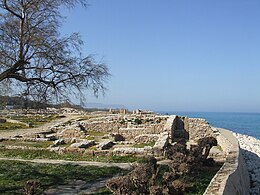Kerkouane
| Punic city of Kerkouane and its necropolis | |
|---|---|
|
UNESCO world heritage |
|

|
|
| Kerkouane on the Mediterranean coast |
|
| National territory: |
|
| Type: | Culture |
| Criteria : | iii |
| Surface: | 11.19 hectares |
| Reference No .: | 332 |
| UNESCO region : | Arabic states |
| History of enrollment | |
| Enrollment: | 1985 (session 9) |
| Extension: | 1986 |
The excavation site of Kerkouane (German: Kerkouan) on the Tunisian Cap Bon peninsula is one of the most important archaeological sites in North Africa and has been included in the UNESCO list of world cultural heritage as it is probably the only surviving Punic city.
Kerkouan was probably destroyed during the First Punic War in the so-called Regulus Expedition; but never rebuilt. Excavations have been going on since 1953 and continued with interruptions until 1976. The origins of the city are uncertain, but it is believed that there was a Berber settlement here before the Punic arrived. The earliest Punic objects date to the sixth century BC. The actual city forms a semicircle directly on the sea, but so far no port facilities have been discovered, although the coastline in the city has been explored quite well. A port is therefore suspected outside the city.
The approximately nine hectare large town was densely built up with houses, in the middle of which was a courtyard around which the individual rooms were grouped. Stairs point to upper floors. The building material was mostly local stone, with individual parts of the wall made of carefully hewn stones with rather coarse stones placed between them. The houses were relatively comfortably furnished. There were bathtubs , floors were equipped with a preform of mosaics ( opus signinum ) and the walls had partially modeled stucco. There were gutters that carried rainwater from the roofs. A temple could be identified. The city was surrounded by a wall.
There were pottery and signs of a purple manufacture . It is also believed that glassware was made in the place. Trade certainly had an important economic function. There were imports from almost all the countries of the Mediterranean , including red-figure Attic ceramics and painted Italian vases. Outside the urban area there were at least four necropolises . In one of the graves there was still a wooden coffin, the lid of which is modeled in the shape of a noble lady. The style of the lid is purely Hellenistic and probably dates to the 4th century BC.
gallery
literature
- M'hamed Hassine Fantar: Kerkouan - The Punic city in the Berber country of Tamezrat. Alif, Tunis 1998, ISBN 9973-22-121-4 (published in German, English, French, Italian).
Web links
Coordinates: 36 ° 56 '47 " N , 11 ° 5' 57" E






